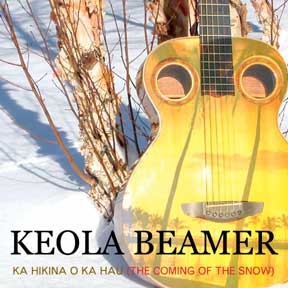KEOLA BEAMER – KA HIKINA O KA HAU
September-October 2007
Artist: KEOLA BEAMER
Title: KA HIKINA O KA HAU (THE COMING OF THE SNOW)
Label: DANCING CAT

Ka Hikina O Ka Hau represents a new exploration with slack key guitar by one of the foremost contributors to the Hawaiian musical renaissance that began in the 1970's. Keola Beamer applies traditional slack-key tunings to both traditional and classical material, collaborating with pianist-record producer GeorgeWinston and guitarist-arranger Daniel O'Donoghue to create an album of delicate beauty. In most of the pieces, Beamer plays all the guitars through the magic of overdubbing.
The title track, composed by Beamer, evokes the mythological snow goddess, Poli'ahu, who looks down from the peaks of Mauna Kea, nearly 14,000 feet above sea level on the Big Island of Hawa'i. Beamer's trademark haunting harmonies and arpeggiation permeate the piece while the piano work of GeorgeWinston, plucking and muting strings inside his instrument give it an unusually rich texture.
Beamer gives tender treatment to two traditional folksongs, Tutu Maramba (Brazilian) and Cantar Montanes (Spanish), both dreamy and reflective in mood. A third, El Rossinyol (The Nightingale), played on two nylon string guitars, presents a courtly style appropriate for its origins.
Many of the selections O'Donoghue adapted for guitar have a folk feeling to them even though most were composed. Beamer gives The Spinning Song, by Albert Ellmenreich, a perky, crisp interpretation that paints a picture of female industriousness. Rimsky-Korsakov's Song of India drifts in languorous perfection, played by three steel string guitars in Keola's C Wahine Tuning while Felix Mendelssohn's Venetian Boat Song moves at a similar pace in a G-minor based tuning, played by two nylon string guitars.
O'Donoghue's special affection for Argentinean music shines in two arrangements. Milonga, composed for piano by Alberto Ginasterais, is based on a well-known Argentinean folk rhythm while Ciquilin de Bachin is a waltz by Astor Piazzolla, best known for his tangos. Beamer brings home the vibrant spirit of these compositions with seeming effortlessness.
The most delightful surprise of the album comes with the Satie arrangements: two Gymnopedie and two Gnossienne selections. While many of Satie's piano works have been arranged for orchestra and solo instruments, these stand out for their lightness and delicacy. Two of them were joint arrangements by Beamer and O'Donoghue. Beamer's exquisite interpretations in various slack key tunings show his appreciation for the French aesthetic.
In his liner notes, Keola Beamer cautions the reader-listener that Ka Hikina O Ku Hau was never intended to be a slack key recording. "It poses a rather simple question. Can the palette, coloration and tonalitiy of Ki Ho'alu (slack key guitar playing) add an indefinable something to the interpretation of songs written by truly great composers?"
The answer is a rather simple, resounding yes!
Audrey Coleman is a journalist, educator, and passionate explorer of world music and culture.













